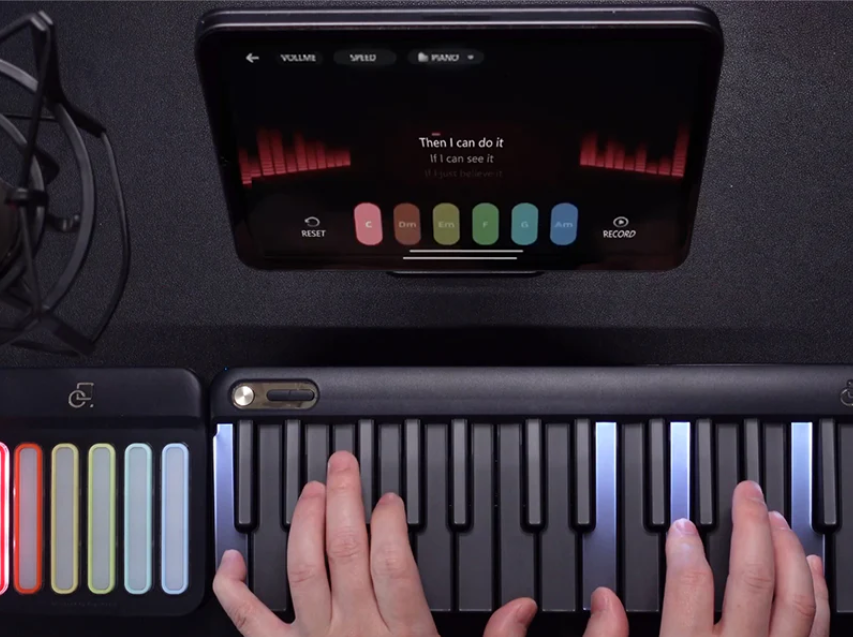
Walk into any music shop—or scroll through a few online listings—and the words keyboard and digital piano start blurring together. Both have black‑and‑white keys, both promise “great piano sound,” and both claim to be perfect for learners.
Yet the difference between a digital piano and keyboard is real, and picking the wrong one can leave you stuck with gear that slows your progress instead of inspiring it.
This deep‑dive guide unpacks every major factor so you can decide with confidence. We’ll cover feel, sound, learning features, price, and even long‑term maintenance. Along the way, we’ll show where a smart hybrid option like the Smart Keyboard fits and why it bridges the gap for many modern players.
A digital piano aims to replicate an acoustic piano in both feel and tone while ditching strings, hammers, and constant tuning. You get:
The umbrella term keyboard covers everything from a $99 toy with 32 mini keys to a $4,000 workstation used on world tours. For beginners, the most common features include:
Below is a side‑by‑side rundown focused on what first‑time buyers truly notice.
|
Feature |
Digital Piano |
Keyboard |
|
Key Feel |
Weighted, graded hammer action mimics acoustic |
Semi‑weighted or synth action, lighter touch |
|
Sound Focus |
Grand‑piano realism; fewer voices overall |
Wide variety of voices, arranger styles, drum kits |
|
Polyphony |
Often 128–256 notes (or modeled) |
32–128 notes on entry‑level boards |
|
Pedals |
Sustain included; triple pedal optional/standard |
Often single sustain jack or no pedal |
|
Speaker Power |
Strong, stereo; built to fill a room |
Varies widely; smaller drivers for portability |
|
Weight & Size |
25–120 lbs depending on model |
5–25 lbs on budget units |
|
Price Range |
$500–$3,000+ |
$100–$1,500 (workstations cost more) |
Both categories now offer built‑in metronomes, lesson modes, and Bluetooth connectivity, but they do it differently.
|
Feature |
Digital Piano |
Keyboard |
Smart Hybrid (PopuPiano) |
|
Guided Lessons |
Often via companion app |
Onboard “follow‑the‑lights” or screen prompts |
LED keys + game‑style scoring |
|
App Integration |
Bluetooth MIDI with third‑party apps |
Same, though cheaper boards skip Bluetooth |
Dedicated PopuMusic app with interactive tutorials |
|
Recording |
Two‑track MIDI record/playback common |
Some include multi‑track song recorders |
App records MIDI & audio for instant sharing |
Smart hybrids combine the visual cues of a keyboard with gradual skill building closer to a piano curriculum, which is why many parents pick them for kids who’d otherwise drift to gaming.
Realistic piano technique relies on the sustain pedal—and eventually soft and sostenuto pedals.
Digital pianos in the $800+ range usually tick every box. Budget keyboards sometimes leave you with a single headphone jack.
|
You Are… |
Grab a |
Why |
|
Absolute beginner, no theory, want fun |
Smart Keyboard (PopuPiano) |
LED guides, gamified practice, app feedback keep motivation high. |
|
Teen taking classical lessons |
Portable Digital Piano |
Weighted keys build finger strength; headphone jack saves parents’ ears. |
|
Songwriter on the go |
61‑key Keyboard with MIDI |
Lightweight, variety of voices, easy hookup to laptop. |
|
Adult returning to music after 20 years |
Console Digital Piano |
Authentic feel, built‑in pedals, living‑room aesthetics. |
|
YouTube cover artist |
Smart Keyboard + DAW |
Visual appeal for viewers; MIDI output for pro audio tracks. |
A digital piano forces correct finger strength and dynamic control earlier. A keyboard’s light touch lets you focus on notes first, technique later.
Absolutely. Look for Bluetooth MIDI or a USB‑B port. PopuPiano even pairs instantly with its own guided‑practice app.
Not strictly. Many beginners ride happily on 61 or 73 keys for the first year. If Beethoven is on your bucket list, plan to upgrade.
If you’re serious about classical performance degrees, practice on weighted 88‑key action as soon as possible.
PopuPiano isn’t a strict digital piano or a standard keyboard—it’s a smart hybrid designed for today’s multitasking lives:
Choosing between a digital piano and a keyboard isn’t about which label sounds fancier. It’s about matching feel, sound, and lifestyle fit to your musical goals. Decide whether authentic hammer action or portability matters more right now, think about learning features that’ll keep you practicing, and balance budget against long‑term value.
Most of all, pick the instrument that makes you excited to sit down and play every single day. Honestly, that daily grin is the best spec of all.
Ready to start? Test‑drive a few boards in person if you can, or dive straight into a smart solution like PopuPiano. Your first song awaits—let’s make it happen.
Read more

Exploring the Different Types of Piano Keyboards for Every Player
You’ve probably noticed that “keyboard” gets tossed around to describe just about anything with black‑and‑white keys. Yet walk into any music store (virtual or brick‑and‑mortar) and you’ll see doze...

Cost of Learning Piano vs Using a Smart Keyboard
The dream is simple: sit at the keys, play your favorite song, feel that goose‑bump little rush. The question that stops many beginners cold is how much that dream is going to cost. Should you buy ...